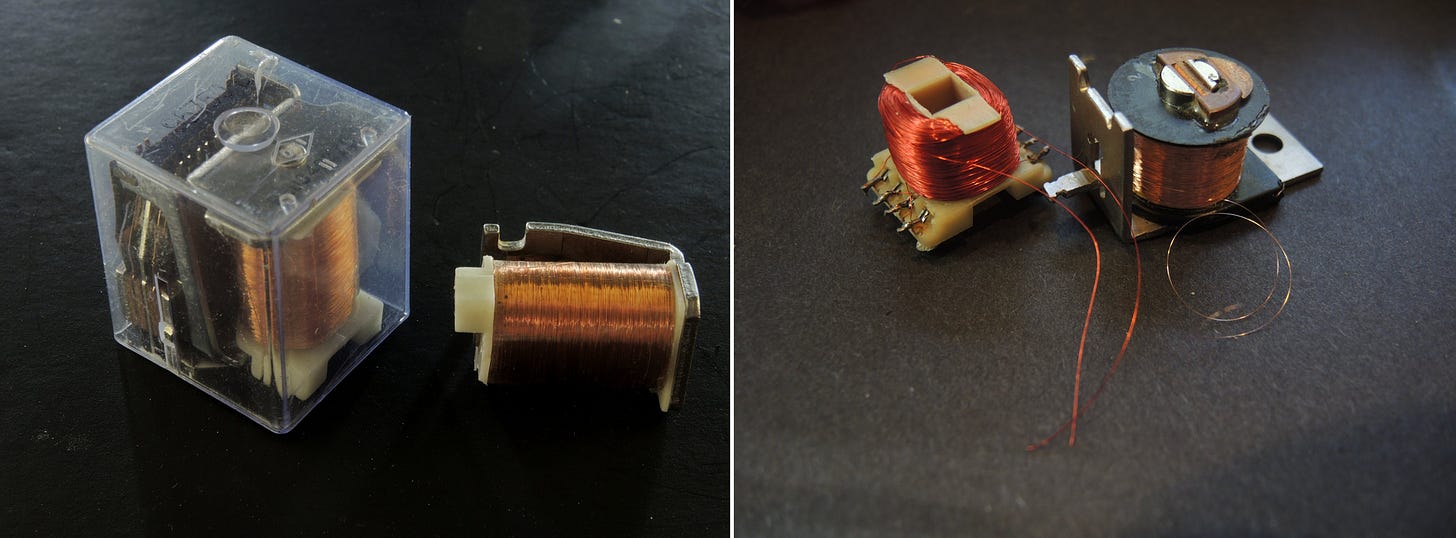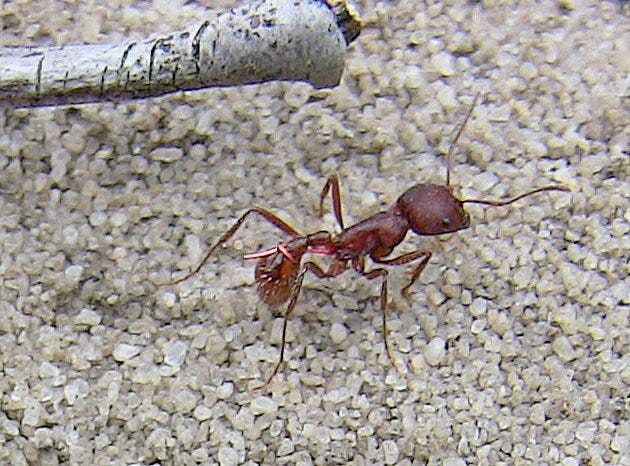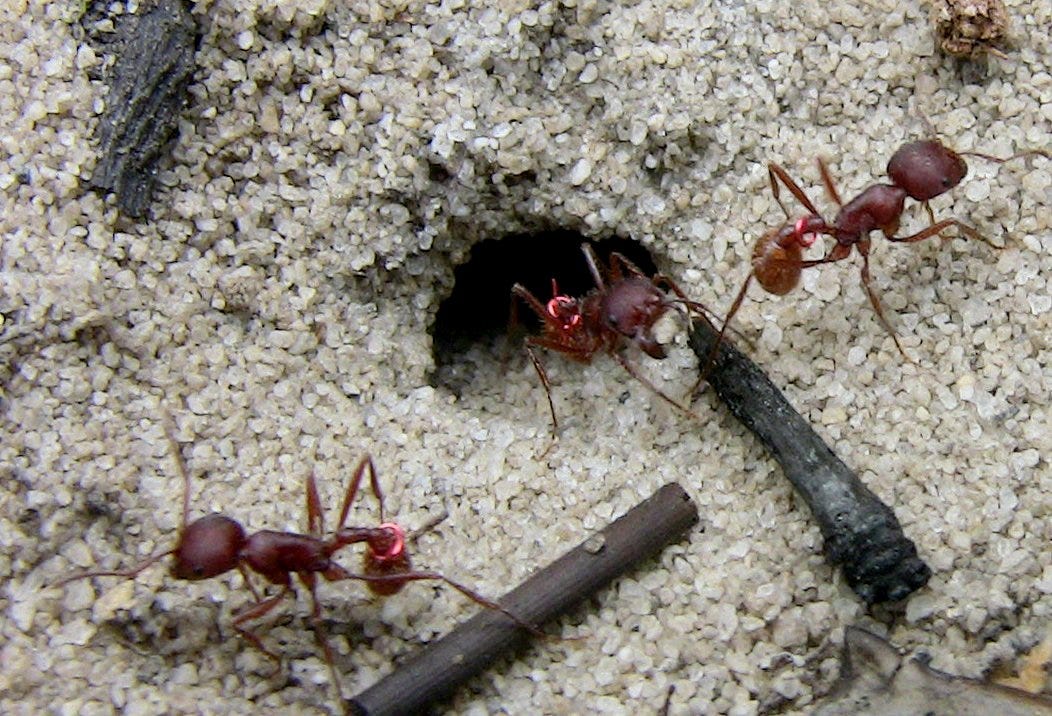Not all my Found Objects are of a natural origin--- a few are man-made, acquired through scrounging. A diligent scrounge like me can find no end of useful items in a junk yard such as Leon Scrap Metals. Or at least I used to could (as we say in the South), because a lot of junk yards now greatly restrict scrounging. The excuse for keeping us scroungers out is almost always “insurance.” How convenient! --- a distant, unnamed, faceless, and characterless insurance company that has apparently said, in no uncertain words, don’t let that scrounging Tschinkel in your yard or we will jack up your insurance bill by $589,098 per month.
In a way, it is satisfying to learn that I am that dangerous and worth that much. On the other hand, how am I going to find all the cast-off junk that no longer has value to the original owner (other than its weight as scrap metal) but can be of very high value to someone with imagination. Space shuttle parts, cannon control cables, stainless steel kitchen sinks, steel I-beams, hunks of steel from unknown sources, aluminum pipe, all could be scrutinized for uses by the serious scrounge. How else would I have been able to turn a 16-foot, 8” diameter stainless steel pipe that had once filled the Apollo 11 tank with liquid oxygen into the stovepipe for our wood burning stove? No matter what gizmo I wanted to build, useful metal pieces could always be found at the scrap yard.
Probably the most enduring contribution of this scrounging to science resulted from finding several scrapped old-fashioned telephone exchanges, those with actual mechanical switches. Each exchange contained dozens of arrays of plastic boxes with complex contacts that responded to the magnetic impulses created by a coil of very fine copper wire. I immediately saw a use for this wire, but scrap was sold by the pound, and the minimum sensitivity of the yard’s scale was about 10 lbs. So, my handful of little wire coils did not register on the scale even when I got on with them, and I finally bought a handful of them for $1.
The fine copper wire of the coils was 38 or 44 gauge (about as thick as a human hair), came in green, vermilion or copper coating and solved a crucial problem in our ant research. There are many situations in which it is desirable to identify individual ants, or groups of ants. Researchers have tested dozens of inks, paints, and lacquers to mark ants with colored dots. This has always worked fine in the short run. But what if you want to identify a marked ant a year later, or even over its lifetime? Paints, inks, and lacquers tend to flake off, rub off or fade over such a long time, especially in soil-dwelling ants exposed to abrasion and moisture. For this purpose, a truly permanent mark was needed, and what better than a wire tied around the ubiquitous ant “waist”?
The first major use I made of wire-marking was to show that among fire ants, overwintering female alates (potential future queens), mated during the first warm days of spring, and rather than trying to start their own colony in the common fire ant way, that is, alone, using metabolic stores in their bodies, they sought out mature fire ant mounds that they attempted to enter. I suspected that if the mature colony happened to be orphaned, the alien newly-mated queen had a chance of acceptance by the orphaned workers, and thus to become the colony queen.
To show that this happened, I collected scores of newly mated female alates and tied a 38-gauge copper belt around their petioles (waists)--- just a simple overhand knot pulled tight with the long ends cut off. There was no way a queen could lose this mark. I then orphaned six colonies and released two wire-marked queens on each mound each day for five days. Upon digging up these colonies seven weeks later, I recovered the fully functional wire-marked queens in two colonies (two remained queenless and two had unmated queens).
My marked queens had become the new queens of the orphaned colonies and had used the workers to rear their own daughters, eventually replacing all the original workers in the colony with her own. Because fire ant colonies are simple families of full sisters, the host workers got no benefit from raising unrelated workers, making this queen a social parasite. It is an alternate reproductive strategy and exists because the chances of its success are about as good as attempting the more common worker-less (independent) founding in late spring.
But it was my student Christina who carried out wire-marking on an industrial scale in order to answer a basic question in ant biology. It has long been known that worker ants change tasks depending on their age, and that only the oldest workers leave the nest to forage. A very approximate age can be assigned to workers based on the color of their cuticle, which darkens with age. The great majority of past research has been carried out in simple, laboratory nests that show little resemblance to real nests in the ground. For the Florida harvester ant, the contrast is between a nest in a plastic box from Walmart and a complex underground world extending two to three meters into the ground with up to over a hundred chambers. How does worker division of labor play out in this complex nest?
To complicate things further, in the Florida harvester ant, workers are born only between May and October. What is the schedule of age and task across an annual cycle, including the five or so months when there is no foraging? To do this, Christina dug up and captured all the workers in six harvester ant colonies through the year, separated workers into three cuticle color groups (using the Pantone scale), and then tied a different color #38-gauge copper wire around the waists of each group. This meant up to 1000 knots on up to 1000 squirming workers in each colony.
After each colony was marked, she returned it to a nest created by burying a series of chamber-shaped ice linked with a tube. After the ice melted this formed a good facsimile of the natural nest. The ants quickly adopted these nests as their own and went about their lives as normal. Over the period of about a year, Christina regularly visited these colonies to collect foragers (using baits) and inspect them for wire belts.
The reward for this deferred gratification was the picture that emerged: workers appeared on the surface as foragers in lockstep order of their estimated age at marking. Workers that were dark colored (the oldest) at the time of marking were the first to appear on the surface as foragers. Those marked when they were ruddy colored appeared later, replacing the dark colored ones as those died off during foraging. Workers marked when they were very light colored (callows) were the last to appear and gradually replaced the dark and medium-colored workers among the foraging class. After that, all new foragers were unmarked, having been born after the colony had been “marked and replanted.” This showed a very strong association between worker age, task and location in space.
But colony life is seasonal, and colonies stop foraging in early November. What is the fate of workers born in the autumn? These first appeared as foragers in the spring when they were over 200 days old, having overwintered in the nest and moved through their age-based tasks slowly. In contrast, summer workers sped through their development quickly and became foragers at an average age of 43 days. But no matter when workers began to forage, their life expectancy after becoming foragers was the same and brief, only about three weeks on average. Therefore, the total life span of the workers, including the foraging period, was about 9 to 10 weeks for summer workers, but 33 to 35 weeks for the autumn workers. There were thus two kinds of workers--- short-lived, fast-developing workers born in summer, and long-lived, slow-developing workers born in autumn. Remarkably, even the body color of the autumn workers reflected their slower development. Many marked as callow or ruddy in the fall were still recognizably lighter in the spring. In contrast, summer workers blazed through their development and were fully dark within only a few weeks.
A few spools of very fine wire (along with an enormous amount of work) have shined a light on a phenomenon that we humans tend to obsess about--- aging. That people age at different rates and die at different ages is easily observed. Yet here is an ant that controls the aging rate and lifespan of workers, leading to short-lived and long-lived workers. But the ants haven’t stopped with workers--- the mother of these workers (the queen) outlives them by more than thirty-fold. These observations raise the question of just what is “aging” and why do lifespans vary? How are both controlled, biologically?
Discussions of aging in people rarely acknowledge that our intrinsic lifespan, like those of all creatures, results from the action of natural selection on our life history over a very long time and is a fundamental biological trait of the human species. The modest variation in lifespan among humans is the raw material on which natural selection acts. To ignore the enormous range of lifespans across the animal kingdom, from a few days to centuries, should tell us that if living for 200 years improved our reproductive success, we would live (on average) for 200 years. If the optimum hovered around 20 years, then that would be our average lifespan. The promise (by some scientists) of extending the human lifespan significantly has to be seen in this light, but in turn raises the deeper question, what for?
Who would have expected that fine wire from discarded telephone equipment would help answer a basic question of ant natural history and raise interesting questions about human lifespans? But then, success in life often depends on how we respond to opportunity, even when that opportunity resides in discarded telephone exchanges. And to exploit that opportunity, you must have that 40-gauge wire handy.







Great piece! Lots of good info, and I love that you tied it to human aging as well.
But I can't get out of my mind the image of your assistant carefully tying wires to the midsections of ants, over and over, day after day. I'm imagining her out on a blind date, "So, what do you do for a living?" and her saying, "Well, for the past two weeks I've been making belts for ants and I'm now up to 895 highly-fashionable runway walkers, and I've only accidentally lethally over-tightened the belts on 141 of them..."
My eyes ache just thinking about it. Again, thanks for the great writing! and research!